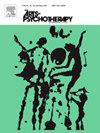Professional development of creative arts therapists: Foundations, experiences and paths
IF 1.5
3区 心理学
Q3 PSYCHOLOGY, CLINICAL
引用次数: 0
Abstract
Creative arts therapists are interdisciplinary professionals with diverse backgrounds and fields of intervention, required to be experts at integrating expressive-creative processes with the therapeutic process. Due to the complexity and duality of this work, and the multiple influences they experience, the professional identity of creative arts therapists has been under discussion, mainly in countries where the profession is recognized and professional institutions established. The objective of this study was to explore the foundations, characteristics and paths of the professional identity of creative arts therapists in a country where the profession is not yet recognized.
Method
Content analysis of semi-structured interviews with beginners and senior arts therapists working in Portugal.
Results
Six themes emerged: Training conditioning, Practice conditioning, Creative and Expressive path, Therapeutic path, Intervention, and Self-Reflection. Participants mentioned social and personal influences on their path, including family, creative-expressive aspects and personal therapy. Arts were the main theoretical foundations referenced by the participants, with emphasis on drama and movement, and within psychology, mainly dynamic and group approaches. The main guides of professional practice are the patients they work with, highlighting the therapeutic relationship. Other relationships are also highly relevant as motivators for self-reflection, especially those with colleagues. The main conflicts regarding professional identity occur in the art and therapy axis, while the main point of cohesion is between personal and professional life.
Conclusion
These results are crucial for shaping both academic training and professional practice, ensuring the continued growth and recognition of arts therapy as a vital profession in Portugal.
创意艺术治疗师的专业发展:基础、经验与路径
创造性艺术治疗师是具有不同背景和干预领域的跨学科专业人员,需要成为将表达-创造性过程与治疗过程相结合的专家。由于这项工作的复杂性和双重性,以及他们所经历的多重影响,创造性艺术治疗师的职业身份一直在讨论中,主要是在职业被认可和专业机构建立的国家。本研究旨在探讨创意艺术治疗师职业认同的基础、特征和路径,在这个职业尚未被认可的国家。方法对在葡萄牙工作的初级和高级艺术治疗师的半结构化访谈进行内容分析。结果出现了六个主题:训练条件反射、实践条件反射、创造性和表达路径、治疗路径、干预和自我反思。参与者提到了影响他们人生道路的社会和个人因素,包括家庭、创造性表达方面和个人治疗。艺术是参与者参考的主要理论基础,强调戏剧和运动,而在心理学中,主要是动态和群体方法。专业实践的主要指导是他们所处理的病人,强调治疗关系。其他关系也与自我反省密切相关,尤其是与同事的关系。职业认同的主要冲突发生在艺术与治疗轴心,而衔接的主要点在个人生活与职业生活之间。这些结果对于塑造学术培训和专业实践至关重要,确保艺术治疗作为葡萄牙重要职业的持续发展和认可。
本文章由计算机程序翻译,如有差异,请以英文原文为准。
求助全文
约1分钟内获得全文
求助全文
来源期刊

Arts in Psychotherapy
Multiple-
CiteScore
3.20
自引率
11.10%
发文量
66
期刊介绍:
The Arts in Psychotherapy is a dynamic, contemporary journal publishing evidence-based research, expert opinion, theoretical positions, and case material on a wide range of topics intersecting the fields of mental health and creative arts therapies. It is an international peer-reviewed journal publishing 5 issues annually. Papers are welcomed from researchers and practitioners in the fields of art, dance/movement, drama, music, and poetry psychotherapy, as well as expressive and creative arts therapy, neuroscience, psychiatry, education, allied health, and psychology that aim to engage high level theoretical concepts with the rigor of professional practice. The journal welcomes contributions that present new and emergent knowledge about the role of the arts in healthcare, and engage a critical discourse relevant to an international readership that can inform the development of new services and the refinement of existing policies and practices. There is no restriction on research methods and review papers are welcome. From time to time the journal publishes special issues on topics warranting a distinctive focus relevant to the stated goals and scope of the publication.
 求助内容:
求助内容: 应助结果提醒方式:
应助结果提醒方式:


